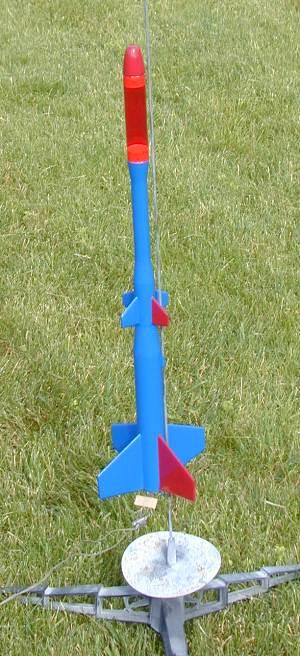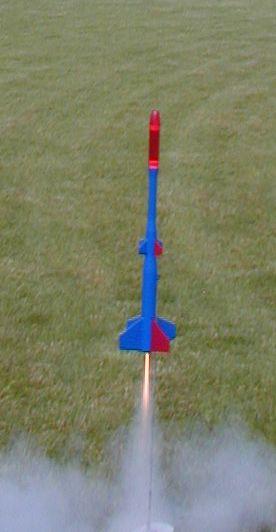Thrustline Aerospace Star Hauler
Thrustline Aerospace - Star Hauler {Kit}
Contributed by Nick Esselman
| Manufacturer: | Thrustline Aerospace |
![[Picture]](/images/archive/images/ratings/rating_ta_star_hauler.gif) (07/15/04) The Thrustline Aerospace Star Hauler is a "payload"
rocket with some appealing looks, at least to me. Interesting, even since
seeing it, I wanted to build it. Not because it was a payloader, but because of
looks.
(07/15/04) The Thrustline Aerospace Star Hauler is a "payload"
rocket with some appealing looks, at least to me. Interesting, even since
seeing it, I wanted to build it. Not because it was a payloader, but because of
looks.
I think the most appealing thing about the Star Hauler is the number of transitions it has: three. It also uses a red see-through plastic payload section to be a bit different.
I purchased it along with the Flux Probe through eBay. It is now my third Thrustline kit, which also includes the Mighty Mick. I have also just purchased two more Thrustline kits that have "caught" my eye. Thrustline is doing a good job in "catching" my eye on his original stuff.
The kit includes three body tubes, three transitions, a balsa nose cone and a red see-through plastic payload bay. It also has an 18mm motor mount with thrust ring and retainer hook. A 12" mylar parachute with a Kevlar® tether and elastic shockcord complete the recovery system. There is a balsa sheet to cut out the eight fins and a launch lug.
 CONSTRUCTION:
CONSTRUCTION:
The instructions are printed on 3 ½ pages (single-sided) of 8½ x 11" paper. There are black&white photos throughout to assist in the assembly of the kit. There is also two fin templates and two tube marking guides on another single page. Lastly, there is Mylar parachute assembly instructions on another single page. The rocket is fairly easy, but would probably be considered a skill level 3 kit.
The motor mount is assemble first and is fairly routine in its assembly. Thrustline uses masking tape to hold the center of the retainer hook down, whereas some bigger manufacturers have a thin tube that slides down over the hook. Masking tape works.
The slot for the hook needs to be cut in the centering ring by the builder, no big deal. Also, the Kevlar® tether is tied around the motor tube and thread through the upper centering ring. Like I said, fairly routine stuff here.
Next the eight fins are cut out, matched and airfoiled. That takes the most work in building this kit (I take that back, finishing is the most work). There is plenty of 1/8" balsa for this.
I did find a mistake in the instructions, which I reported and Thrustline has fixed. In step #8, it says to place the upper fin guide on the 4" wide body. This should be the 2.1" section according to the pictures. This also makes the template too wide. I was able to resolve this by cutting the template to size and wrapping it around the 2.1" section of tube.
Since this rocket uses solid balsa transitions, the separation point is at the BT55 (largest lower tube) to BT50. The transition gets a washer and an eye-screw attached. The elastic is tied to the Kevlar® tether and then to the eye-screw. The parachute, with swivel is attached to the eye-screw as well.

The launch lug is cut in half and placed at the top and bottom of the BT55 tube. The next step was a first for me. Not really sure why the step is there, but it was described very well in the instructions. That is to glue the second thrust ring onto the first to make a double-length thrust ring with the Kevlar® sandwiched in-between. Perhaps Thrustline has determined that this protects the Kevlar® more.
Thrustline does give finishing guidance including dealing with the payload section. They suggest several coats of sandable primer, sanding in-between. This is how I finish my rockets as it is.
The real trouble is that all the transitions and nose cone are balsa, so they show grain lines badly. I used Elmer's Fill-n-Finish, for the first time, on this kit. It greatly helped, but let those transitions take a lot of work!
I used my typical multiple coats of Plastic-Kote Primer and sanding in-between. I then used some left over Krylon Navy Blue and then I painted one large, one small fin, and the nose cone Red. I think I like Thrustlines finishing better for looks, but mine is okay.
Overall, for CONSTRUCTION I would rate this kit 3 ½ points. The instructions are descriptive and fairly easy to follow. Cutting your own fins can turn some away, but I'm okay with it. However, in this case there were eight fins to cut and it was a note paper template. Why not cardstock? The quality of the parts were fine and everything fit well. The recovery system is excellent. No decals.
 FLIGHT/RECOVERY:
FLIGHT/RECOVERY:
Thrustline recommends "to start out with an A8-3 and work your way up".
Thrustline indicates the rocket should weigh 1.3 ounces. My rocket weighed in at 2.0 ounces.
I decided to fly it for the first time on an A8-3. After loading in three sheets of wadding, and putting in the parachute, it was ready to fly.
The payload section is simply friction fit and I didn't have to add any masking tape for it to be tight. I didn't have a payload.
This was a front yard launch and I got a couple nice pictures. I didn't expect it to be still going up at ejection, but that was the case with the A8-3. Perhaps an A6-4 would be in order. At ejection the parachute did not unfurl. This is probably because I had rolled throughout finishing and never unrolled it prior to flying. No damage and I would consider it a good first flight.
My second flight was on an A8-3 again and this time everything went perfectly!
My third flight was on a B6-4 and this time ejection was at apogee. The parachute did not open up and there was a small burn/melted spot in the 'chute. I used 5 sheets of wadding, but with it sitting so close to the motor tube, I guess some got through.
The fourth flight was on a Quest C6-5. The flight was high and ejection was at apogee. The 'chute did open, but also was ripped in two. Mylar is better than plastic, except it does tear.
For FLIGHT/RECOVERY, I would rate this rocket 3 points. It is a stable rocket and all except the A8-3 flight, it seemed to fly as expected. Had trouble with the mylar 'chute opening and then tearing, but probably due to my wadding packing.
I give the rocket an OVERALL rating of 3 ½ points. It is a unique looking model rocket that performs well on A8's for back (front) yard flying. A nice mylar 'chute and solid recovery system. Takes a bit of work to get a nice finish on it, but looks pretty good without any paint as well! It has the payload section, so you could experiment with it as well.
 |
 |
Flights
Sponsored Ads
 |
 |











